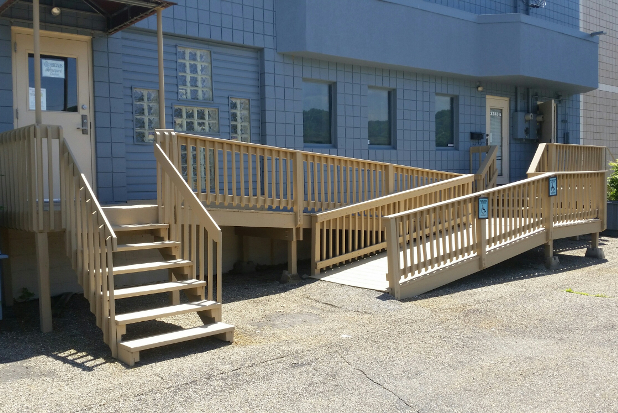
Building ramps makes areas more easily accessible to people who have trouble using stairs or use walkers, personal scooters, and wheelchairs. As the population of this country grows older, the need for things like wheelchair ramps is becoming more pronounced in both public buildings and private residences, as well. In some cases, installation is a relatively easy operation, but in homes where space is limited or tight (as is the case in many homes built decades ago as well as in some newer houses), installing ramps might present more of a challenge.
Access Ramp Guidelines
Although the guidelines for residential wheelchair ramps are not as stringent as those for public areas, many neighborhoods with codes and restrictions in place have specific rules about where ramps are allowed and how they should be built.
No matter where you live, it is generally a good idea for access ramps to have non-skid surfaces. If you’re building a wheelchair ramp outdoors, it should also be constructed so water cannot accumulate on walking surfaces. Handrail position and height should also be taken into consideration. For access ramps that lead to doors (i.e. in an entryway), the way that the door swings may also need to be altered.
Ready to start your Wheelchair Ramp?
Find ProsMaintenance for Wheelchair Ramps
An older wheelchair ramp is only as good as the work you put into it. A ramp that isn’t properly maintained could pose more of a hazard than having no ramp at all! With wooden ramps, boards may need replacing. Wooden ramps also may need to be repainted or resealed periodically to protect the wood and guard against rot or other destabilizing factors. Older ramps might need to be fitted with nonskid material, and handrails may need to be secured. Metal handrails may need to be re-welded and have guard rails or pickets added. Metal access ramps should also be free of rust, and may need to be sealed periodically.
DIY Wheelchair Ramp Installation
Though most homeowners would probably leave a job like installing an access ramp to the pros, the do-it-yourselfers out there will find that this job can be done well without professional help as long as you follow the building codes established in your area. Here are a few things that will give you an idea of what building a wheelchair ramp is going to entail:
- Ramps should have a maximum slope ratio of 1:12, which means 12 feet of ramp per each foot of elevation.
- Although a 1:12 pitch (12 feet of ramp per each foot of elevation) is the maximum slope allowed, a gentler slope of 1:14 or 1:16 is preferable, one might decide to change the slope of a concrete ramp as the disabled person becomes older or weaker.
- A level area must be located at the top and bottom of a ramp. If a porch is not present at the top, a platform should be placed over the steps in front of the door. No run over 30 feet is allowed without an intermediate resting platform. This platform may be a straight or turn platform.
- If there is not enough area to install a straight ramp, it may be necessary to build cross runs from side to side.
- Any platform that changes direction must be at least 60″ x 60″ for wheelchair maneuverability. Ramps should be at least 36 inches wide, but a 44-inch to 48-inch width is recommended when installing handrails on the inside of a ramp.
- If a ramp has a rise greater than six inches, or a horizontal projection greater than 72 inches, it should have handrails on both sides.
- The top of the handrail should be mounted between 30 and 34 inches above the ramp.
 Home Design for Fall Prevention for Seniors
Home Design for Fall Prevention for Seniors  11 Home Security and Safety Tips
11 Home Security and Safety Tips  Modern Design Trends & Advice for Aging in Place
Modern Design Trends & Advice for Aging in Place  Best Cities for Sidewalks and Winter Safety
Best Cities for Sidewalks and Winter Safety  Fire Extinguishers
Fire Extinguishers 

Are You Familiar With This Topic? Share Your Experience.